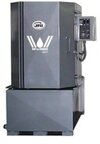Yep, that`ll be me then.Many months (years?)I have gazed upon the bare cases of my Shadow with furrowed brow...... The logistics of painting the engine, with regard to prepping-i.e. sandblasting as the only really thorough way of ensuring the paint sticks, and somehow keeping that gritty poison out of the insides is a recurring nightmare.Add to that the tales of doom from the perils of modern fuels and their ability to outperform Nitromors, gushing from the bottom of incontinent type 29`s........... Hmmm, White Shadow Eh?
You are using an out of date browser. It may not display this or other websites correctly.
You should upgrade or use an alternative browser.
You should upgrade or use an alternative browser.
Engine painting
- Thread starter Bigmart
- Start date
In the US, Simonize is a car wax, not a paint?
Hi Bruce
I think Simonize is the manufacturer, I was surprised to find they made paint.
H
Howdy sir,
Not only is media blasting potentially lethal to your motor, it is not very effective. Your best insurance against paint rejection with alloy parts having any exposure to hot oil is to have it/them cycled through the unit depicted below. This is referred affectionately at Pat Williams Racing as the "dishwasher." The parts rotate on a rack within while being sprayed with a very hot solution (in this case it contains a touch of caustic soda), the oil is literally boiled out of the pores and washed off. Comprehensive automatic transmission rebuild shops have these.
For paint, Glasurit polyurethane in high solids format is ...can't claim impervious with ever changing fuel formulation, but, almost completely resistant to fuels. I have had a motor in service nearly 20 years that has lost none of its gloss and is occassionally wiped down with BrakeKleen. Apply a thin base of acid etch primer as an adhesion promoter only. If wet sanding/polishing desired, I'd save that step for the color coat as primers don't have the density of top coats and if built up, crush/flair out more readily under washers/fasteners than top coats. Originality may not be an issue here but Shadow motors did not have uniform gloss all over like what is generally seen on restorations these days. The heads/cylinders were almost semi flat, that cases a little glossier and the usual polished bits on a Rapide the shiniest.

Not only is media blasting potentially lethal to your motor, it is not very effective. Your best insurance against paint rejection with alloy parts having any exposure to hot oil is to have it/them cycled through the unit depicted below. This is referred affectionately at Pat Williams Racing as the "dishwasher." The parts rotate on a rack within while being sprayed with a very hot solution (in this case it contains a touch of caustic soda), the oil is literally boiled out of the pores and washed off. Comprehensive automatic transmission rebuild shops have these.
For paint, Glasurit polyurethane in high solids format is ...can't claim impervious with ever changing fuel formulation, but, almost completely resistant to fuels. I have had a motor in service nearly 20 years that has lost none of its gloss and is occassionally wiped down with BrakeKleen. Apply a thin base of acid etch primer as an adhesion promoter only. If wet sanding/polishing desired, I'd save that step for the color coat as primers don't have the density of top coats and if built up, crush/flair out more readily under washers/fasteners than top coats. Originality may not be an issue here but Shadow motors did not have uniform gloss all over like what is generally seen on restorations these days. The heads/cylinders were almost semi flat, that cases a little glossier and the usual polished bits on a Rapide the shiniest.

